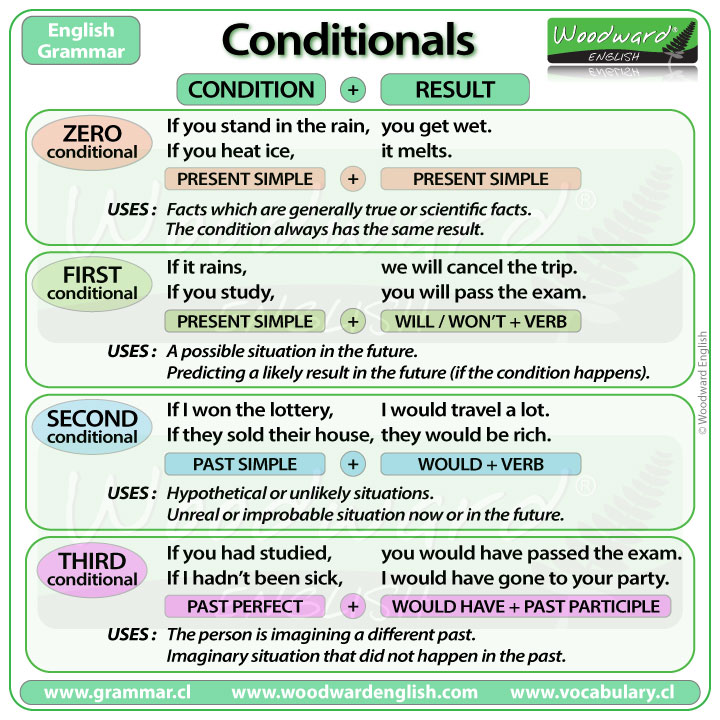Conditional Sentences and IF clauses – Introduction
Conditional sentences consist of two parts:
The if-clause (which is a condition) and the main clause (which is a result)
For example:
- If it rains, we will cancel the trip.
If it rains …. is the if-clause (the condition)
An if-clause begins with IF and has a subject and a verb.
We will cancel the trip …. is the main clause (the result)
If introduces a condition. This is something that may or may not happen, depending on the circumstances.
We don’t know exactly if it is going to rain so we say… IF it rains,
And what is the result of this condition? We will cancel the trip.
There is always a condition and a result.
The IF-clause introduces a condition. The main clause is the result of that condition.
What happens in the main clause is conditional to what happens in the if-clause. In other words, the main clause only happens when the events in the if-clause happen.
Note: There are two ways of ordering a conditional sentence.
Condition, + Result (with a comma after the condition) …. OR …
Result + Condition (without a comma)
Look at the original sentence
- If it rains, we will cancel the trip.
Notice how there is a comma after the verb rains which is the last part of the if-clause.
When the if-clause comes first in the sentence, we put a comma (,) after it.
- If it rains,(COMMA) we will cancel the trip.
BUT, when the main clause comes first in the sentence, the comma (,) is not necessary.
- We will cancel the trip if it rains.
(Notice how there is no comma in this last sentence)
You can use either order, they are both used and correct.
TYPES OF CONDITIONALS
The four main types of conditionals are:
The Zero Conditional, the First Conditional, the Second Conditional, and the Third Conditional.
Sometimes these are called Type 0, Type 1, Type 2, and Type 3 Conditionals.
We will quickly introduce them in this lesson and go into more detail about each conditional in individual lessons.
The Zero Conditional
This involves the present simple + present simple
This is used for facts that are generally true or scientific facts.
The condition always has the same result.
- If you stand in the rain, you get wet. (This is generally true)
- If you heat ice, it melts. (This is a fact)
The First Conditional
This involves the present simple + will / won’t + verb
This is used to express a possible situation in the future.
We are predicting a likely result in the future if the condition happens.
For example:
- If it rains, we will cancel the trip.
(This is the likely result in the future if it rains) - If you study, you will pass the exam.
(Again, I predict that this will happen in the future if you study)
The Second Conditional
This involves the past simple + would + verb
This is used for hypothetical or unlikely situations.
Also for unreal or improbable situations now or in the future.
- If I won the lottery, I would travel a lot.
(It is unlikely that I will win the lottery. But in this hypothetical, though improbable situation, this is what I would do)
- If they sold their house, they would be rich.
(It is unlikely that they will sell the house because they like living there. However, in this improbable situation of them selling the house, they would become rich)
The Third Conditional
This involves the past perfect + would have + past participle
This is used when a person is imagining a different past, an imaginary situation that did not happen in the past.
- If you had studied, you would have passed the exam.
(I imagine that if you had done this in the past, the result would have been different)
- If I hadn’t been sick, I would have gone to your party.
(I’m imagining the situation of NOT being sick in the past… something that I cannot change now)
In general:
Zero conditional refers to facts.
First conditional and Second conditional refer to the present or future. However second conditional sentences suggest it is less probable or imaginary.
Third conditional refers to the past.
There are MORE than these 4 types of conditional sentences though these are the ones that are used the most. We will look at other types in future lessons.
Summary Chart

